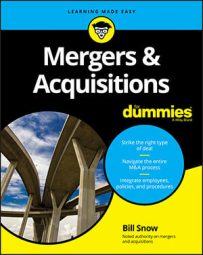Mergers and acquisitions are simply buy-sell transactions. You can’t sell something unless you have a buyer for it. You can’t buy something without a seller. In the vast world of M&A, there’s more than one type of each.
A close up look at buyers in M&A
In documents and contracts and agreements, you usually see Buyer as a defined term, which means it’s capitalized. When you read those documents, Buyer looks like the name of a person. In fact, to make it seem really formal, M&A professionals often drop the word the from Buyer.
“Buyer” isn’t a one-size-fits-all category. A Buyer may acquire all or part of a company, the stock of the company, or certain or all assets and even assume some of the liabilities. Despite this wide variety of possibilities, Buyers typically fall into four broad types:
Strategic Buyers: These Buyers are other companies planning to combine operations of the two companies to some extent (as opposed to buying strictly for financial reasons). For example, when Oracle buys a company, Oracle is considered a strategic Buyer because it buys companies that have some sort of synergy to its business.
Financial Buyers: Financial Buyers are funds of money that buy companies. Financial Buyers of middle market and lower middle market companies are typically private equity (PE) funds, which are essentially large pools of money.
Other companies backed by PE funds: The company will be the new owner of the acquired company, but another entity (the fund) is providing the dough to do the deal.
Individuals: Although it happens, an individual buying a middle market or lower middle market company is rare. When individuals buy companies, those companies tend to be small retail shops, consulting firms, or construction companies. Typically, these companies have revenues of less than $1 million.
As a Seller, know that who’s on the other side of the negotiating table may change the way your M&A process works. Are the Buyers experienced deal people, or are they new to the process? For example, if your Buyer is a PE firm, rest assured that the people you’re negotiating with know exactly what they’re doing.
Types of sellers in the M&A world
Seller is a defined term, meaning it’s capitalized for the purposes of documents and contracts.
Here’s a quick look at the types of Sellers you may find in the world of M&A:
The spinoff: A company may be divesting a division, a product line, or certain assets.
The change of control: This company is selling enough of itself (more than 50 percent) to result in a change of control. In these cases, the owner or owners most likely receive the money. Colloquially, this approach is called taking some chips off the table.
The recap: Sometimes an owner wants to take some chips off the table without giving up control of the company. This situation is called a recapitalization, or recap for short.
The growth capital: A Seller may issue more stock for the purposes of raising capital to invest in the business. In this case, the owner isn’t actually selling the company but rather selling more stakes in the company. The money from the sale doesn’t flow to the owner; instead, the company retains the money to fund growth.
Remembering why the Seller is selling the company, how much of the company he or she is selling, and where the money goes is key. Follow the money.

